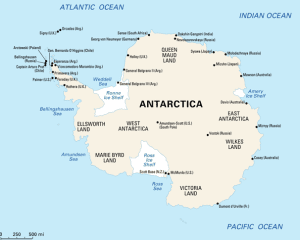TAG: GS 1: GEOGRAPHY
THE CONTEXT: Antarctica, despite its frozen exterior, harbors a surprising amount of volcanic activity. With 138 volcanoes concealed beneath the ice, the continent presents a unique landscape of geological phenomena. In this article, we will explore the volcanic activity in Antarctica, focusing on Mount Erebus, its gold-rich emissions, potential environmental impacts, and the challenges of monitoring and predicting eruptions.
EXPLANATION:
- Antarctica boasts 138 volcanoes, 91 of which were only recently discovered in 2017.
- While many are deemed dormant or extinct, notable eruptions have occurred in recent history, including those of Penguin Island in 1905, Deception Island in 1970, and Mount Erebus in 1972.
- Mount Erebus, standing as Antarctica’s tallest active volcano, features a perpetual lava lake within its summit crater, making it a subject of scientific intrigue.
- Satellite imagery reveals Mount Erebus’s active lava lake, which has been erupting continuously since at least 1972.
- These eruptions, known as strombolian eruptions, emit plumes of gas and steam, occasionally containing tiny specks of gold.
- Despite their minuscule size, these gold particles accumulate, resulting in an estimated daily output of 80 grams, valued at over $6,000.
- The dispersion of gold particles over vast distances highlights the unique nature of volcanic emissions in Antarctica.
Monitoring and Predicting Eruptions
- Antarctic volcanoes pose significant challenges for monitoring and prediction due to logistical and climatic obstacles.
- Accessing these remote locations is arduous, and monitoring instruments must withstand harsh conditions and long polar nights.
- Consequently, predicting eruptions and assessing their potential impact remain complex tasks for researchers.
Environmental Implications
- While the eruptive activity of Antarctic volcanoes may seem benign, historical evidence suggests potential environmental consequences.
- Studies suggest that past eruptions, such as those of Mount Takahe approximately 18,000 years ago, released ozone-depleting halogens, contributing to ozone layer depletion and climate warming.
- Although the likelihood of such events recurring is uncertain, the environmental impact of future eruptions remains a subject of scientific inquiry.
Antarctica:
- Antarctica is Earth’s southernmost and least-populated continent.
- Situated almost entirely south of the Antarctic Circle and surrounded by the Southern Ocean (also known as the Antarctic Ocean), it contains the geographic South Pole.
- Antarctica is the fifth-largest continent, being about 40% larger than Europe, and has an area of 14,200,000 km2 (5,500,000 sq mi).
- Most of Antarctica is covered by the Antarctic ice sheet, with an average thickness of 1.9 km (1.2 mi).


